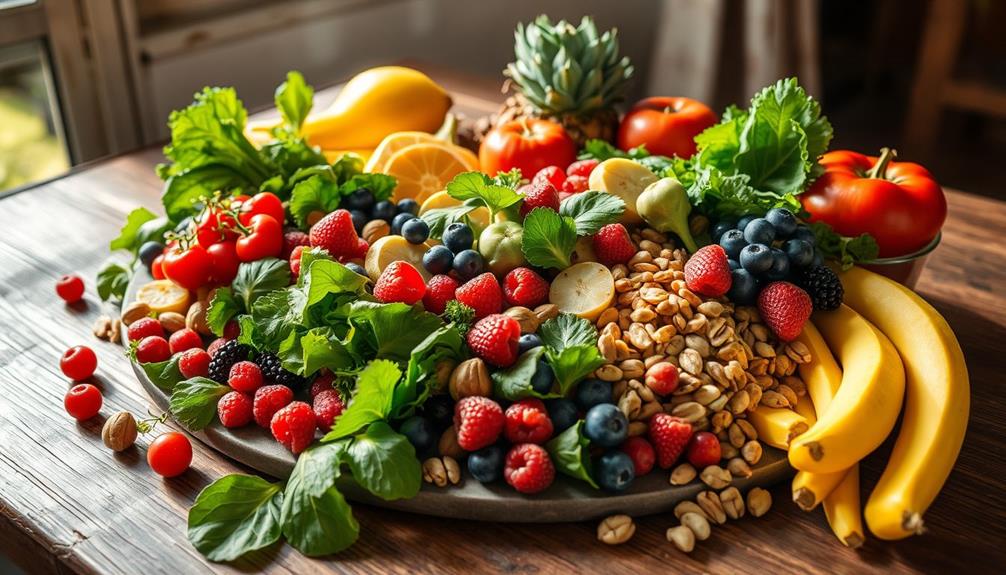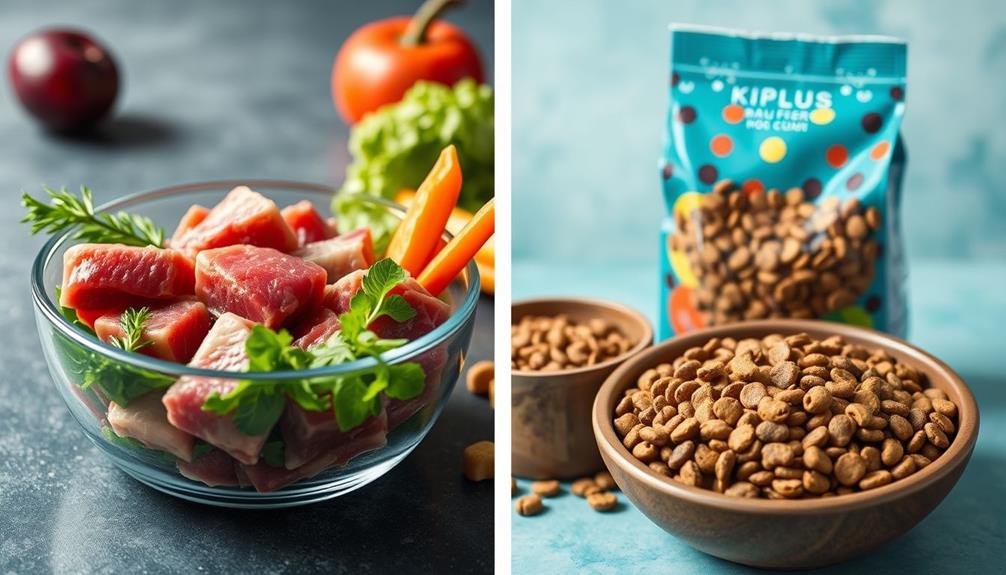Feeding your kitten the right amount of raw food is essential for their growth and health. For a kitten aged 2-4 months, aim for 10-13% of their body weight daily. Once they reach 4-8 months, reduce it to 6-10%, and for 8-14 months, provide 3-6% of their body weight. Offer smaller, frequent meals, ideally 2-3 times a day, to optimize digestion. Keep an eye on their weight and adjust portions as needed. By following these guidelines, your kitten can thrive on a raw diet—stay tuned to uncover more tips for successful feeding!
Key Takeaways
- Kittens aged 2-4 months should be fed 10%-13% of their body weight daily for optimal growth.
- Offer smaller, frequent meals (2-3 times daily) to enhance digestion in kittens.
- Transition to a raw diet gradually and monitor for digestive issues like diarrhea.
- Regularly track weight and adjust food portions based on growth and activity levels.
- Ensure proper hygiene practices when preparing and storing raw food to prevent contamination.
Feeding Guidelines for Kittens
When it comes to your kitten's nutrition, understanding feeding guidelines is vital for their growth and well-being. Kittens have specific nutrient requirements that change as they grow.
For those aged 2-4 months, you should feed them about 10%-13% of their body weight per day to support their rapid growth and energy needs. As they reach 4-8 months, the recommended portions decrease to 6%-10% of their body weight daily, reflecting a stabilizing growth rate.
It's important to reflect on the quality of food you provide, as using raw cat food can be beneficial for effective relief and overall health. Once your kitten is 8-14 months old, you'll want to provide 3%-6% of their body weight each day, marking their shift into young adulthood.
It's essential to offer smaller, more frequent daily meals—ideally at least 2-3 times a day. This helps optimize digestion and guarantees they absorb the nutrients effectively.
Using raw cat food can be a great way to meet these feeding guidelines, as long as you balance their meals to maintain healthy growth. By paying attention to these guidelines, you can help your kitten thrive and develop into a healthy adult cat.
Nutritional Benefits of Raw Food

Raw food diets for kittens offer numerous nutritional benefits that are fundamental for their growth and development. These diets provide essential amino acids, vitamins, and dietary macronutrients, all important for fostering healthy growth.
The enhanced digestibility of raw formulas means your kitten can absorb nutrients more effectively, promoting overall health and keeping energy levels high, which is especially significant for active little ones. Additionally, a proper diet can help prevent common health issues, making it important to take into account ultimate hamster care practices when choosing food options.
You'll also find a variety of highly palatable raw food options that stimulate your kitten's appetite, making it easier for them to enjoy their meals. Nutritional guidelines suggest that kittens need to consume 10%-13% of their body weight in food daily, ensuring they receive the right nutrients during their rapid growth stages.
Moreover, a balanced raw diet can help address common digestive issues seen in kittens. By focusing on high-quality ingredients, you enhance their ability to absorb nutrients, leading to better overall well-being.
When you prioritize these nutritional benefits in your kitten's diet, you set the stage for a healthy, vibrant life as they grow and develop.
Transitioning to a Raw Diet

Shifting your kitten to a raw diet can be a rewarding process, but it requires careful planning and observation. Start by determining how much raw food to feed your kitten, aiming for about 10-13% of their body weight if they're 2-4 months old. Incorporating healthy dog snacks can also be beneficial for overall health.
You can choose between a gradual introduction by mixing raw food with their current diet or making an abrupt switch, depending on how adaptable your kitten is.
During this change, it's best to offer smaller, more frequent meals—at least 2-3 times daily. This approach supports their digestive health and energy needs as they adjust. Be sure to monitor for any digestive issues such as diarrhea or vomiting. If you notice significant problems, be prepared to adjust the diet or consult your veterinarian.
Hydration is also essential during this time. Always provide fresh water to help your kitten adapt to their new raw diet.
With careful observation and adjustments, your kitten can thrive on a raw food diet, paving the way for a healthier future. Remember, each kitten is unique, so listen to their needs throughout this change.
Monitoring and Adjusting Portions
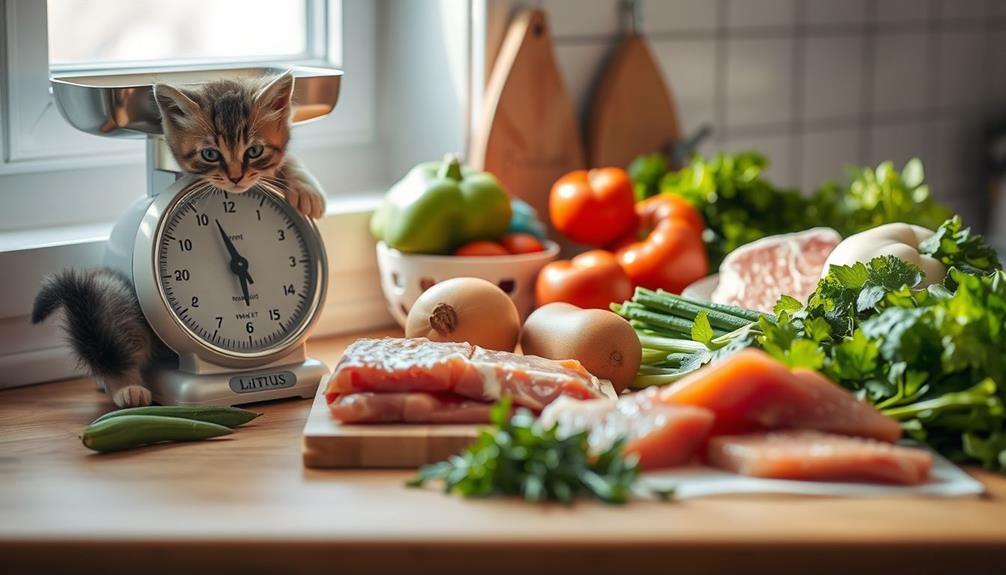
To keep your kitten healthy, you'll need to regularly track their weight and adjust their food portions accordingly.
It's important to take into account factors such as the right balance of nutrition for your pet's growth stage and guarantee that their diet is suitable for their specific needs, similar to how financial planning for elderly care requires careful consideration.
Pay attention to their activity levels and appetite, as these can signal when it's time to make changes.
Weight Tracking Techniques
When it comes to guaranteeing your kitten's healthy growth, regular weight checks are essential. Aim to conduct these checks every 1-2 weeks to monitor their progress accurately. Use a digital scale at home or visit a local vet for precise measurements.
Keep track of any weight changes in a feeding log, as this can help you identify trends over time. Additionally, understanding the signs of newborn constipation can provide insights into your kitten's overall digestive health.
Furthermore, assess your kitten's body condition score (BCS) to evaluate their overall health. This involves looking at their body shape and fat coverage to determine if your kitten is underweight, at an ideal weight, or overweight.
Adjust food portions based on the weight changes you observe. If your kitten loses weight, increase their food intake, while a gain might necessitate a reduction in portions. The goal is to promote consistent growth without rapid fluctuations.
Adjusting for Activity Levels
Understanding your kitten's activity level is essential for determining the right amount of food to support their growth and energy needs. Kittens aged 2-4 months typically require 10%-13% of their body weight daily, while those 4-8 months need 6%-10%. If your kitten is particularly active, aim for the higher end of these ranges to meet their caloric needs.
Additionally, guaranteeing your kitten's health through regular check-ups can help identify any nutritional deficiencies, similar to how essential oils for respiratory health can support overall well-being.
Regularly monitor your kitten's body weight and adjust their food intake as necessary. If you notice weight loss after changing their diet, it's a sign to increase their portions. Active kittens might need up to 4% of their body weight in food, while less active or overweight ones should start around 2%.
Utilizing a body condition score chart can help you assess your kitten's health. This tool allows you to evaluate their body composition and adjust your feeding practices accordingly.
Identifying Dietary Changes
Regularly monitoring your kitten's weight and overall health is vital for identifying dietary changes. Incorporating a balanced diet is essential for their growth and development, as it impacts their overall well-being.
Start with regular weight checks to determine if adjustments to their raw food portions are necessary. If your kitten loses weight after changing diets, it might be a sign to increase their food intake. Utilize body condition score charts to assess your kitten's body fat and overall health, allowing you to fine-tune the feeding amounts based on their individual needs.
Additionally, guaranteeing adequate hydration is key to supporting their health and kidney function, as proper hydration can greatly influence their energy levels and appetite hydration as a key factor.
Pay close attention to your kitten's appetite and energy levels. A reduced appetite or increased lethargy may indicate that dietary changes or even medical attention are required. Conversely, if your kitten is gaining weight unexpectedly, consider decreasing food portions or adjusting the feeding schedule.
Always adapt feeding amounts in line with your kitten's age, activity level, and general health status. Younger kittens typically need around 10%-13% of their body weight in raw food for ideal growth, with this percentage gradually decreasing as they mature.
Safety and Hygiene Practices
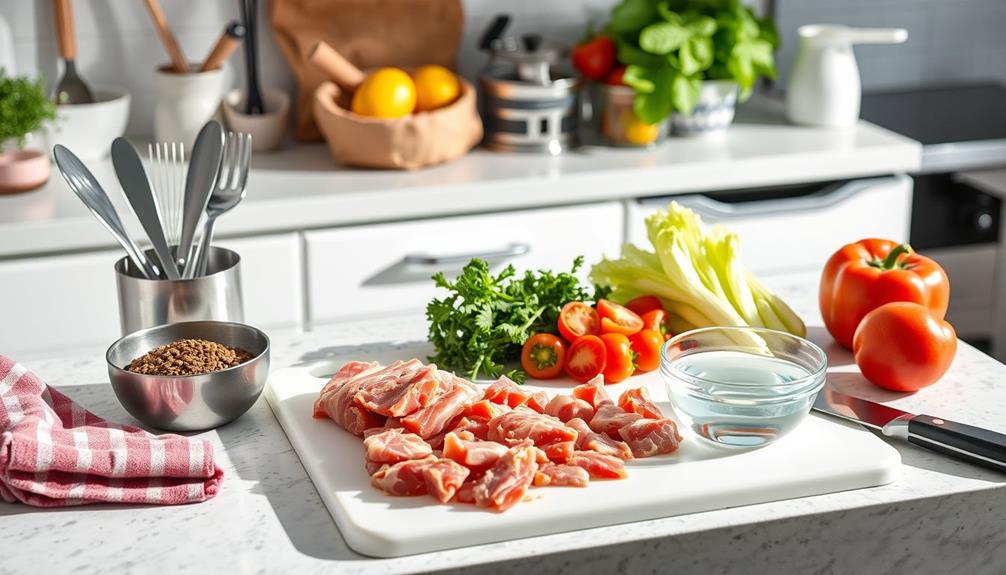
Guaranteeing safety and hygiene while handling raw food for your kitten is fundamental to prevent cross-contamination and protect both your pet and your household. Always use separate cutting boards and utensils when preparing raw food. This minimizes the risk of spreading harmful bacteria.
Before and after handling raw food, wash your hands thoroughly with soap and water. This simple step is imperative in maintaining hygiene. Additionally, you might want to take into account using an air purifier maintenance guide to ascertain that your environment remains clean and free from allergens, which is beneficial for your kitten's health.
When storing raw cat food, use appropriate containers in the refrigerator or freezer. This helps maintain freshness and reduces bacterial growth. Regularly clean your food preparation surfaces and utensils with hot, soapy water or a bleach solution to guarantee proper hygiene.
Contemplate wearing gloves while preparing raw food. This additional layer of protection further reduces the risk of contamination and helps maintain cleanliness throughout the process.
Community Feedback and Support

A vibrant community of cat owners can be an invaluable resource when it comes to steering through the world of raw feeding for your kitten. Engaging with fellow cat enthusiasts allows you to share experiences, tips, and strategies for effective raw feeding.
Many owners have reported significant health benefits for their cats after shifting to a raw diet, and their stories can inspire and guide you. Additionally, understanding the importance of budgeting for pet care can guarantee you allocate the right resources for your kitten's diet and health needs.
Community feedback often highlights common challenges, such as overfeeding and weight management. By discussing these issues, you can learn from others and adopt personalized approaches that suit your kitten's specific needs. Each cat is unique, and what works for one may not work for another. This is where the collective knowledge of the community shines, helping you navigate any hurdles you encounter.
Moreover, ongoing interactions in forums provide opportunities for continuous learning, keeping you updated on best practices in raw feeding. As you engage with other cat owners, you'll find support and encouragement, making the shift smoother for both you and your kitten.
Embrace the community, and you'll not only enhance your knowledge but also foster a healthier, happier life for your furry friend.
Understanding the PMR Diet
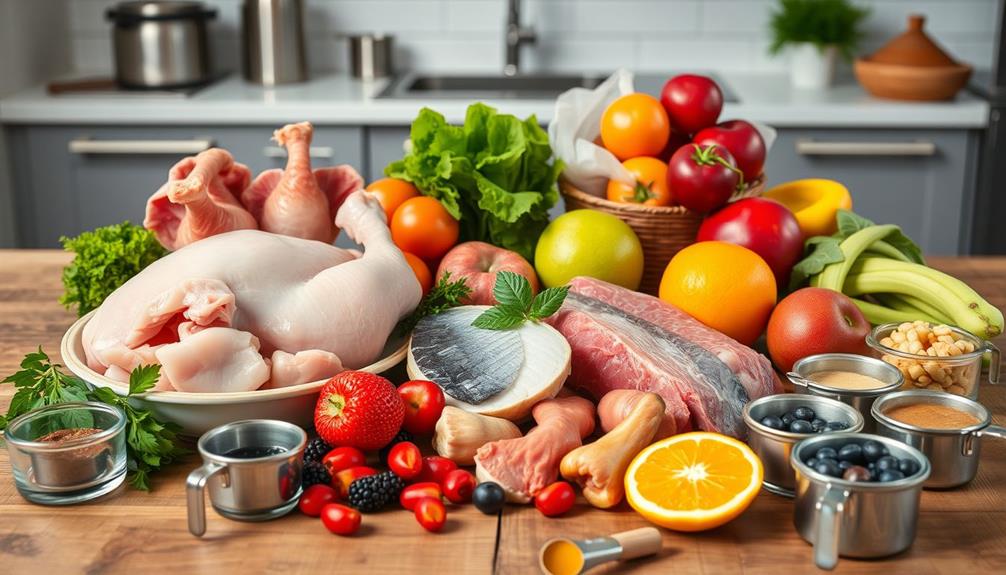
The PMR diet is designed to meet your kitten's specific nutritional needs through a carefully balanced composition.
It's vital to understand the percentages of muscle meat, bones, and organs to guarantee your kitten gets all the essential nutrients for healthy growth.
Additionally, incorporating a variety of protein sources can further enhance their diet and support overall well-being, similar to the way juice diets can provide essential nutrients in a different context.
PMR Diet Composition
Kittens thrive on a well-balanced PMR (Prey Model Raw) diet, which is fundamental for their growth and development. Understanding the PMR diet composition helps you provide the right nutrients for your furry friend.
The ideal makeup consists of 64-69% muscle meat, which is essential for delivering important protein and amino acids. This forms the largest portion of their diet, guaranteeing they've the energy to play and grow.
Next, include 17% raw edible bone, critical for providing calcium and phosphorus, key minerals needed for developing bones and teeth.
Additionally, you should incorporate 7% liver, which supplies fat-soluble vitamins like A and important minerals such as copper. Other organs, also at 7%, contribute considerably to the overall nutritional profile, enhancing the diet's benefits.
While traditional PMR guidelines often overlook it, adding 0-5% animal-based fiber can be beneficial. This small amount promotes colon health and helps prevent nutritional deficiencies in your kitten.
Nutritional Balance Importance
Nutritional balance is fundamental for a kitten's health and development, especially when following a PMR diet. This diet focuses on providing high-quality raw food that mimics the natural prey of a cat. To achieve nutritional completeness, your kitten's daily intake should consist of 64-69% muscle meat, which supplies essential proteins and amino acids critical for growth and energy.
Incorporating raw edible bones is equally important, making up about 17% of the diet. These bones provide necessary calcium and phosphorus for strong bone development.
Additionally, liver and other organs should account for 7% of the diet, offering essential fat-soluble vitamins and minerals that support overall health.
To guarantee your kitten thrives, don't forget to add 2-5% animal-based fiber, like fur or feathers. This inclusion promotes healthy digestion and helps maintain colon health.
Frequently Asked Questions
How Much Raw Food Should I Feed My Cat Chart?
To determine how much raw food to feed your cat, consider its age, weight, and activity level. You'll want to adjust the portions regularly based on its growth and nutritional needs for ideal health.
How Much to Feed a Kitten Chart?
Picture your kitten as a budding tree, needing just the right amount of sunlight. You should feed your little one 10-13% of their body weight daily, adjusting as they grow to guarantee healthy development.
What Is the Ratio for a Raw Cat Diet?
For a raw cat diet, aim for 64-69% muscle meat, 17% raw edible bone, 7% liver, and 7% other organs. This balance guarantees your cat gets the essential nutrients for peak health and growth.
Can Kittens Be Fed a Raw Diet?
Sure, you could just feed your kitten pizza, but a raw diet's way better! Kittens can thrive on raw food, giving them essential nutrients for growth. Just make certain it's balanced, or you might be in trouble!
Conclusion
In summary, feeding your kitten a raw diet can be a rewarding choice for their health and vigor. Did you know that kittens fed a balanced raw diet often show a 30% increase in energy levels compared to those on commercial kibble? By carefully following the guidelines and monitoring their progress, you can guarantee your furry friend thrives. Embrace the journey of shifting to raw food, and enjoy the benefits it brings to your kitten's well-being!




